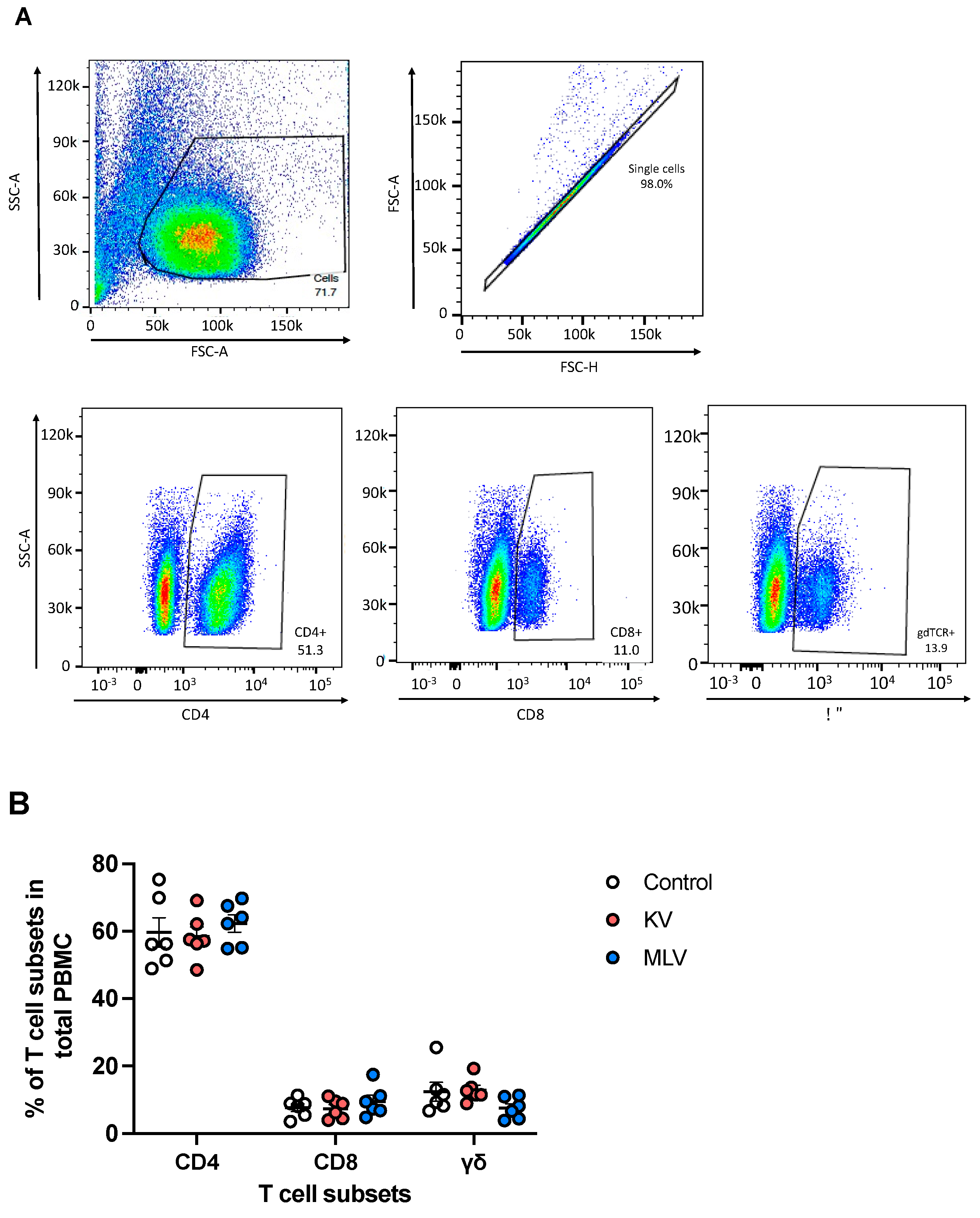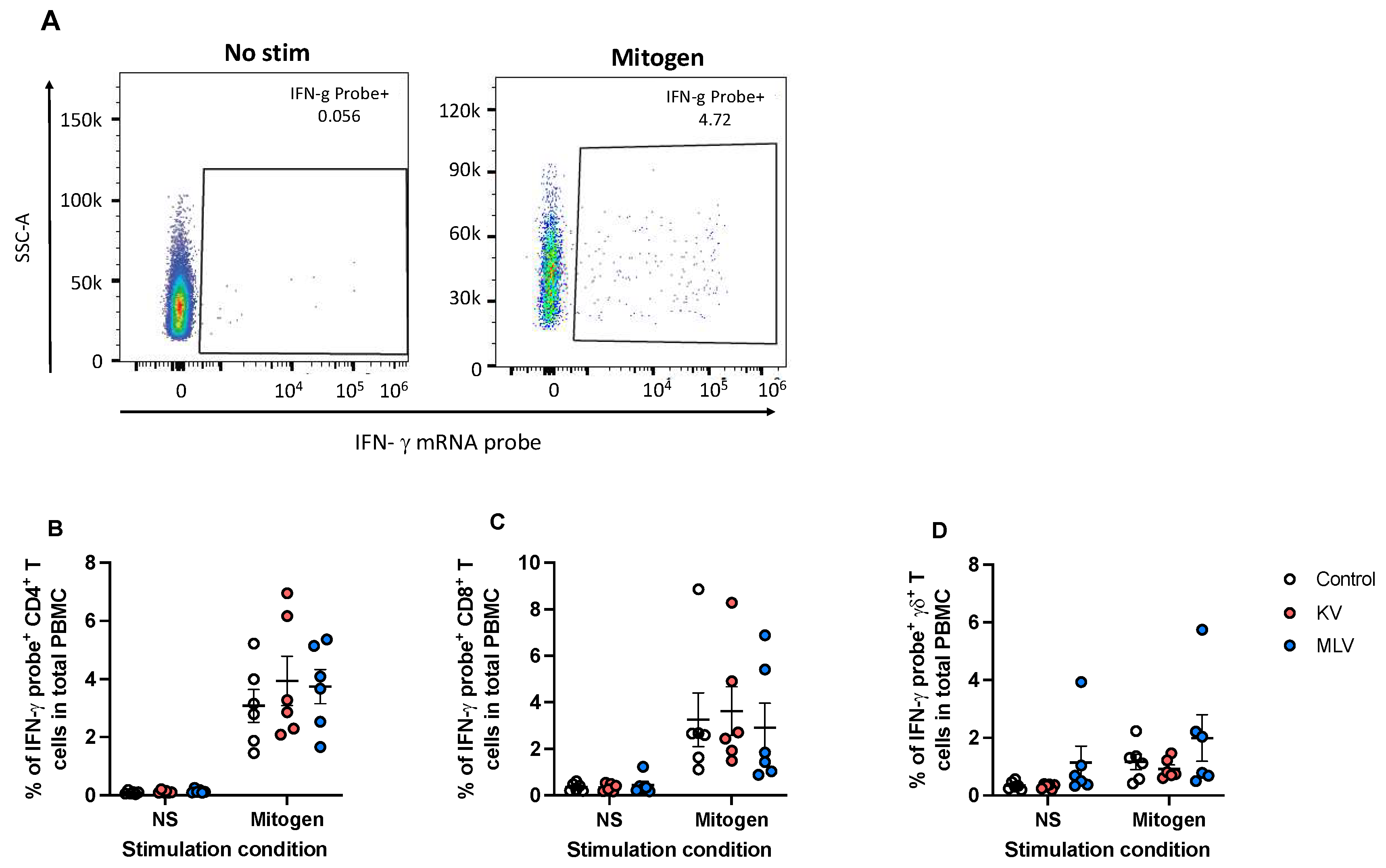Characterization of Cellular and Humoral Immunity to Commercial Cattle BVDV Vaccines in White-Tailed Deer
Abstract
1. Introduction
2. Materials and Methods
2.1. Animals, Vaccination, and Sample Collection
2.2. BVDV Strains
2.3. Serology
2.4. Peripheral Blood Mononuclear Cell (PBMC) Isolation and Stimulation
2.5. In Vitro Stimulation Conditions
2.6. Staining for Flow Cytometry and PrimeFlow
2.7. Data Analysis
3. Results
3.1. Neutralizing Antibody Titers to BVDV-1 and BVDV-2a
3.2. Frequency of Circulating T Cell Subsets and Antigen-Specific IFN-γ Responses
4. Discussion
5. Conclusions
Author Contributions
Funding
Institutional Review Board Statement
Informed Consent Statement
Data Availability Statement
Acknowledgments
Conflicts of Interest
Abbreviations
| BVDV | Bovine viral diarrhea virus |
| WTD | White-tailed deer |
| MLV | Modified live vaccine |
| KV | Killed vaccine |
| CMI | Cell mediated immunity |
| PBMCs | Peripheral blood mononuclear cells |
References
- Willgert, K.; Didelot, X.; Surendran-Nair, M.; Kuchipudi, S.V.; Ruden, R.M.; Yon, M.; Nissly, R.H.; Vandegrift, K.J.; Nelli, R.K.; Li, L.; et al. Transmission history of SARS-CoV-2 in humans and white-tailed deer. Sci. Rep. 2022, 12, 12094. [Google Scholar] [CrossRef] [PubMed]
- VerCauteren, K.C.; Lavelle, M.J.; Campa, H., 3rd. Persistent Spillback of Bovine Tuberculosis From White-Tailed Deer to Cattle in Michigan, USA: Status, Strategies, and Needs. Front. Vet. Sci. 2018, 5, 301. [Google Scholar] [CrossRef] [PubMed]
- Campbell, T.A.; Vercauteren, K.C. Diseases and Parasites. In Biology and Management of White-Tailed Deer; Hewitt, D.G., Ed.; CRC Press: Boca Raton, FL, USA, 2011; pp. 219–249. [Google Scholar]
- Rivera, N.A.; Brandt, A.L.; Novakofski, J.E.; Mateus-Pinilla, N.E. Chronic Wasting Disease In Cervids: Prevalence, Impact And Management Strategies. Vet. Med. 2019, 10, 123–139. [Google Scholar] [CrossRef] [PubMed]
- Saif, L.J.; Jung, K. Comparative Pathogenesis of Bovine and Porcine Respiratory Coronaviruses in the Animal Host Species and SARS-CoV-2 in Humans. J. Clin. Microbiol. 2020, 58, e01355-20. [Google Scholar] [CrossRef] [PubMed]
- Ridpath, J.F.; Driskell, E.A.; Chase, C.C.; Neill, J.D.; Palmer, M.V.; Brodersen, B.W. Reproductive tract disease associated with inoculation of pregnant white-tailed deer with bovine viral diarrhea virus. Am. J. Vet. Res. 2008, 69, 1630–1636. [Google Scholar] [CrossRef] [PubMed]
- Ridpath, J.F.; Mark, C.S.; Chase, C.C.; Ridpath, A.C.; Neill, J.D. Febrile response and decrease in circulating lymphocytes following acute infection of white-tailed deer fawns with either a BVDV1 or a BVDV2 strain. J. Wildl. Dis. 2007, 43, 653–659. [Google Scholar] [CrossRef] [PubMed]
- Passler, T.; Walz, P.H.; Ditchkoff, S.S.; Givens, M.D.; Maxwell, H.S.; Brock, K.V. Experimental persistent infection with bovine viral diarrhea virus in white-tailed deer. Vet. Microbiol. 2007, 122, 350–356. [Google Scholar] [CrossRef] [PubMed]
- Passler, T.; Ditchkoff, S.S.; Givens, M.D.; Brock, K.V.; DeYoung, R.W.; Walz, P.H. Transmission of bovine viral diarrhea virus among white-tailed deer (Odocoileus virginianus). Vet. Res. 2010, 41, 20. [Google Scholar] [CrossRef]
- Newcomer, B.W.; Walz, P.H.; Givens, M.D.; Wilson, A.E. Efficacy of bovine viral diarrhea virus vaccination to prevent reproductive disease: A meta-analysis. Theriogenology 2015, 83, 360–365.e1. [Google Scholar] [CrossRef] [PubMed]
- Walz, P.H.; Givens, M.D.; Rodning, S.P.; Riddell, K.P.; Brodersen, B.W.; Scruggs, D.; Short, T.; Grotelueschen, D. Evaluation of reproductive protection against bovine viral diarrhea virus and bovine herpesvirus-1 afforded by annual revaccination with modified-live viral or combination modified-live/killed viral vaccines after primary vaccination with modified-live viral vaccine. Vaccine 2017, 35, 1046–1054. [Google Scholar] [CrossRef] [PubMed]
- Platt, R.; Burdett, W.; Roth, J.A. Induction of antigen-specific T-cell subset activation to bovine respiratory disease viruses by a modified-live virus vaccine. Am. J. Vet. Res. 2006, 67, 1179–1184. [Google Scholar] [CrossRef] [PubMed]
- Stevens, E.T.; Zimmerman, A.D.; Butterbaugh, R.E.; Barling, K.; Scholz, D.; Rhoades, J.; Chase, C.C. The induction of a cell-mediated immune response to bovine viral diarrhea virus with an adjuvanted inactivated vaccine. Vet. Ther. 2009, 10, E1–E8. [Google Scholar] [PubMed]
- Van Anne, T.R.; Rinehart, C.L.; Buterbaugh, R.E.; Bauer, M.J.; Young, A.J.; Blaha, M.L.; Klein, A.L.; Chase, C.C.L. Cell-mediated and humoral immune responses to bovine herpesvirus type 1 and bovine viral diarrhea virus in calves following administration of a killed-virus vaccine and bovine herpesvirus type 1 challenge. Am. J. Vet. Res. 2018, 79, 1166–1178. [Google Scholar] [CrossRef] [PubMed]
- Deer, W. Deer Farming. 2024. Available online: https://worlddeer.org/deer-farming/ (accessed on 24 October 2024).
- Falkenberg, S.M.; Dassanayake, R.P.; Neill, J.D.; Walz, P.H.; Casas, E.; Ridpath, J.F.; Roth, J. Measuring CMI responses using the PrimeFlow RNA assay: A new method of evaluating BVDV vaccination response in cattle. Vet. Immunol. Immunopathol. 2020, 221, 110024. [Google Scholar] [CrossRef] [PubMed]
- Falkenberg, S.M.; Dassanayake, R.P.; Terhaar, B.; Ridpath, J.F.; Neill, J.D.; Roth, J.A. Evaluation of Antigenic Comparisons Among BVDV Isolates as it Relates to Humoral and Cell Mediated Responses. Front. Vet. Sci. 2021, 8, 685114. [Google Scholar] [CrossRef] [PubMed]
- Bauermann, F.V.; Flores, E.F.; Falkenberg, S.M.; Weiblen, R.; Ridpath, J.F. Lack of evidence for the presence of emerging HoBi-like viruses in North American fetal bovine serum lots. J. Vet. Diagn. Investig. 2014, 26, 10–17. [Google Scholar] [CrossRef] [PubMed]
- Bolin, S.R.; Matthews, P.J.; Ridpath, J.F. Methods for detection and frequency of contamination of fetal calf serum with bovine viral diarrhea virus and antibodies against bovine viral diarrhea virus. J. Vet. Diagn. Investig. 1991, 3, 199–203. [Google Scholar] [CrossRef] [PubMed]
- Falkenberg, S.M.; Dassanayake, R.P.; Crawford, L.; Sarlo Davila, K.; Boggiatto, P. Response to Bovine Viral Diarrhea Virus in Heifers Vaccinated with a Combination of Multivalent Modified Live and Inactivated Viral Vaccines. Viruses 2023, 15, 703. [Google Scholar] [CrossRef] [PubMed]
- Kak, G.; Raza, M.; Tiwari, B.K. Interferon-gamma (IFN-gamma): Exploring its implications in infectious diseases. Biomol. Concepts 2018, 9, 64–79. [Google Scholar] [CrossRef] [PubMed]




Disclaimer/Publisher’s Note: The statements, opinions and data contained in all publications are solely those of the individual author(s) and contributor(s) and not of MDPI and/or the editor(s). MDPI and/or the editor(s) disclaim responsibility for any injury to people or property resulting from any ideas, methods, instructions or products referred to in the content. |
© 2025 by the authors. Licensee MDPI, Basel, Switzerland. This article is an open access article distributed under the terms and conditions of the Creative Commons Attribution (CC BY) license (https://creativecommons.org/licenses/by/4.0/).
Share and Cite
Boggiatto, P.M.; Palmer, M.V.; Olsen, S.C.; Falkenberg, S.M. Characterization of Cellular and Humoral Immunity to Commercial Cattle BVDV Vaccines in White-Tailed Deer. Vaccines 2025, 13, 427. https://doi.org/10.3390/vaccines13040427
Boggiatto PM, Palmer MV, Olsen SC, Falkenberg SM. Characterization of Cellular and Humoral Immunity to Commercial Cattle BVDV Vaccines in White-Tailed Deer. Vaccines. 2025; 13(4):427. https://doi.org/10.3390/vaccines13040427
Chicago/Turabian StyleBoggiatto, Paola M., Mitchell V. Palmer, Steven C. Olsen, and Shollie M. Falkenberg. 2025. "Characterization of Cellular and Humoral Immunity to Commercial Cattle BVDV Vaccines in White-Tailed Deer" Vaccines 13, no. 4: 427. https://doi.org/10.3390/vaccines13040427
APA StyleBoggiatto, P. M., Palmer, M. V., Olsen, S. C., & Falkenberg, S. M. (2025). Characterization of Cellular and Humoral Immunity to Commercial Cattle BVDV Vaccines in White-Tailed Deer. Vaccines, 13(4), 427. https://doi.org/10.3390/vaccines13040427








